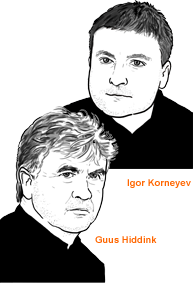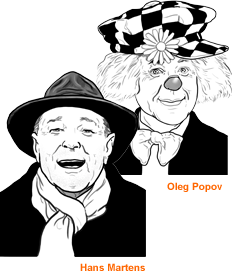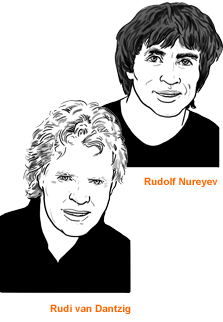Russia & the Netherlands
Passion for the arena
The relationship between the Netherlands and Russia finds expression in a great many meetings, some of them iconic. The previous edition gave you examples of Dutch-Russian ‘meetings of minds’ in the fields of trade, chess and space travel. This edition takes a look at the worlds of football, the circus and ballet. Read all about how top Dutch football manager Guus Hiddink revived the Russian game together with Igor Korneyev. Then find out about two extraordinary Russians who were world-class talents in their respective fields: the clown Oleg Popov and ballet dancer Rudolf Nureyev. Meetings with Dutch people also played a meaningful part in their lives and careers. .
Guus Hiddink and Igor Korneyev

So it was not surprising that Russia set its sights on him as the first-ever foreign manager of its national squad. The Russian national side, that failed to qualify for both Euro 2004 and the 2006 World Cup, was at an impasse. The Dutch coach saw it as a challenge to pilot the Russians to Euro 2008 and chose Russia over England. At first the Russians were sceptical, according to the book Guus Hiddink, portrait of a super coach. They wondered whether Hiddink would be able to identify sufficiently with Russian temperament. Because, while the coach adapted to Russian customs, he couldn’t care less about conventions. He rejuvenated the team and stopped training them at godforsaken locations. In addition he shielded the players from officials and gave them more freedom, thus teaching them to take more of their own responsibility. Hiddink’s approach was that of a modern boss: he commanded authority and respect through his actions, not by giving orders. His assistant Igor Korneyev (1967), a top football player with experience abroad, played a bridging role in this process.
Hiddink and Korneyev’s primary task was to increase the Russian players’ faith in themselves. That was easier said than done. The qualification series for Euro 2008 was a mixed bag, with Russia losing its first away game against England. However, the Russian squad got its revenge in the return leg at home in the Luzhniki stadium (see inset); the team came back from a goal down to beat England 2-1. The considerable euphoria this caused quickly subsided after a defeat to Israel. It looked as if it was all over but England losing to Croatia meant that Russia survived. Russia went on to beat Andorra by a goal to nil and qualified by the skin of its teeth. “It was like playing Russian roulette,” commented Hiddink.
Anyone under the impression that the Russian team settled into more consistent form after that would be wrong. In the tournament the new kid on the block lost its first game 4-1 to eventual winners Spain. Yet again Hiddink had to sharpen up his team: “We’re not here for the beauty prize.” Hiddink courted confrontation and got various players to swap positions. It worked. The games that followed went better: Russia beat Greece by a goal to nil and Sweden by two goals to nil, thus earning itself a place in the quarter- finals. There it was up against the Netherlands, Hiddink’s home country. Following a string of convincing victories, the Orange team were bursting with confidence. But the tactician par excellence showed great skill in punishing the Dutch for this hubris. Hiddink had his young team play with the utmost flair, thus denying the Dutch a chance to get into their game. The super fit Russian team beat the Dutch 3-1 in extra time. Hiddink did a celebratory jig with his assistant Korneyev. From Sochi to Siberia it was party time. Despite losing to Spain in the semi-final the Russian team were given a hero’s welcome at the Luzhniki stadium.
After his career as manager of the national team Hiddink returned to the Russian Federation once again to manage FC Anzhi Makhachkala (Dagestan), a team he led to third place in the Russian competition in 2013 and the last 16 of the Europa League.
Luzhniki Stadium
The Luzhniki Stadium in Moscow is one of the biggest in the world. Built in 1956 it was the backdrop to the opening ceremony of the 1980 Olympic Games. The stadium is currently home to football clubs Spartak Moscow and Torpedo Moscow, and will host both the opening game and the final of the 2018 football World Cup. The stadium is home to the Luzhniki museum, which boasts a large collection of cups, footage and sports paraphernalia, for example relating to Russian Olympic champions. Outside the stadium stands a monument commemorating the tragedy during the 1982 match between Spartak Moscow and Dutch club HFC Haarlem. www.luzhniki.ru/
Oleg Popov and Hans Martens

It was not until he was 24 that he found his ultimate vocation, once again by coincidence. When Borovikov, star clown of the Saratov circus, broke his arm, Popov stepped in as his replacement. He did so with an act he had thrown together late one afternoon with a chef’s hat. It was a resounding success. In the book Oleg Popov, my life as a clown (ghost written by Dutchman Melle van der Velde) the world’s most famous clown said this was the moment that kick-started his career as a clown.
Popov quickly got himself noticed amongst the wealth of Russian circus talent. He presented innovative acts with weird and wonderful props and assistants. Think of the collapsing convertible, an artificial cow or the drowned man spewing out 10 litres of water. His performances often provided the links between circus numbers (and in some cases sent them up). As such they formed a thread running through the performances. This, along with his feeling for marketing, meant that Popov had a high business value for the circuses he worked with. But his greatest gift was his unrivalled tragi-comic presence on stage. With his brilliant miming and distinctive silhouette he made a lasting impression on his audience.
The fact that Popov did not rely heavily on words also made him very suited to an international audience. This became evident when he was selected to take part in the international tour by the Great Russian State Circus, with which his motherland sought to put itself in the spotlight. In the very first city the circus travelled to, Brussels, public interest was overwhelming. Popov – with the blue-and-white checked cap he had once found in a studio – soon turned out to be a favourite with the crowd. He was granted a visit with the Belgian Queen Elisabeth, who nicknamed him ‘the Sunny Clown’. Innumerable foreign appearances followed, not just in Western Europe, but also in Australia, Indonesia, India, Japan, the United States and Cuba. This made Popov a household name both at home and abroad. For 15 years his image was imprinted on billions of Russian chocolates.
On one of his many European tours, in 1979 in Amsterdam, Popov met Hans Martens (1945-2011). He made friends with the Dutchman, who was attached to the Russian State Circus as a business manager. Despite the fact that they spoke different languages, something clicked between them. For one thing they were both dyed-in-the-wool circus folk. Martens, the son of an acrobat, started out as a trapeze artist. By 1980 he had made it all the way to director of his own circus, Circus Holiday, which he established with his business partner at the time Willem Smitt. At the end of the Cold War he persuaded Popov to come to the Netherlands and transformed his Circus Holiday into the Moscow State Circus. Popov decided to settle in the West with his new German sweetheart, Gabriëla Lehman. The two were married in the Dutch city of Breda by mayor Ed Nijpels.
Popov went on performing in the circus for a long time. In 2010 and 2011 he appeared at the ripe old age of 80 in the Netherlands, where he was presented with the Piste Circus Award for his oeuvre. In an interview with the daily De Volkskrant he said: “For me personally the circus is as vital as the air that we breathe.” Martens might have said the same. This circus man said his final goodbye to the high top two years ago.
Museum of Circus Art, St Petersburg
The St Petersburg circus (1877) is a phenomenon. The monumental building houses not only a famous circus but also a remarkable museum. This ‘museum for circus art’ has a large collection of over 90,000 items from the circus world, including programmes, posters and circus equipment, freely donated to the museum by circus artists. The highlights include various Oleg Popov memorabilia, including a bicycle with five Olympic wheels. The museum organises exhibitions and loans out items from its collection for exhibitions abroad. www.circus.spb.ru/en
Rudolf Nureyev and Rudi van Dantzig

The talent of Rudolf Nureyev (1938-1993) as a dancer was recognised early on. Barely into adulthood, he shot up like a comet. As a dancer with the Kirov ballet (Mariinsky Theatre, St Petersburg, see inset) he was given leading parts from an early age. In three years with the Kirov ballet he danced 15 parts, often together with his older dance partner Ninel Kurgapkina. He rapidly became one of the best-known dancers in Russia and was asked to do a European tour in 1961.
During the tour the rebellious dancer did not keep to the regime’s rules. He mixed with foreigners, which he was not supposed to do. It soon became clear to Nureyev that it would be better for his future to remain in the West, and so he applied for asylum and came to dance in Europe, for example at the Royal Ballet in London. Here he found a new dance partner in Margot Fonteyn, a British ballerina almost 20 years his senior. The pair were inseparable. Nureyev once said he and Fonteyn danced “with one body and one soul”. Nureyev had a great impact on ballet. He danced a lot and often, and was one of the first dancers to be active in both classical and modern ballet. With his charisma, and later also his choreographies, he raised the profile of male roles in ballet. Away from ballet Nureyev also became a world star, with frequent appearances both on the silver screen and on television. He famously performed in the popular TV series The Muppet Show, dancing ‘Swine Lake’ with Miss Piggy.
While performing in the Netherlands in 1968 Nureyev invited the talented Dutch choreographer Rudi van Dantzig (1933-2012) to his dressing room. The dancer suggested performing Van Dantzig’s work Monument for a dead boy with the (Dutch) National Ballet. It was the start of a close friendship between the two that was to last 25 years. Their contact was characterised by frequent confrontations because Van Dantzig was critical, not least of the dancer’s airs and graces. To Van Dantzig’s surprise Nureyev remained a loyal companion despite the criticism, the choreographer said in his book The Trail of a Comet. At the behest of the legendary dancer Van Dantzig created another three ballets, and found himself falling into one adventure after another. “Nureyev worked like a giant, lived like a giant and also made gigantic mistakes.”
Van Dantzig was not only amazed by Nureyev’s loyalty but also by his appetite for work. “All the time I knew him, he had worked unremittingly. I don’t think there has been a dancer in history who has danced such a superhuman number of performances and such physically demanding roles. How he found the time and energy to work as a choreographer alongside his existence as a dancer was a mystery to me. The number of productions he created was vast. His eight full-length ballets were rehearsed by over 30 companies around the world.” In the book Van Dantzig emphasises how important Nureyev was to dancing in the Netherlands. “His cooperation with the National Ballet meant a life-giving shot in the arm for the company that was in an extremely precarious state just at that time. With his arrival at our studios our future seemed to take a powerful turn for the better.”
Towards the end of his life Nureyev also gained recognition and rehabilitation in his own country. After being persona non grata for years, by the end of the 1980s he was welcome once again. In 1989 he was invited to dance the part of James in the Kirov Ballet’s production of La Sylphide in the Mariinsky Theatre.
Mariinsky Theatre, St Petersburg
It is no exaggeration to describe the Mariinsky Theatre as the temple of Russian opera and ballet culture. The characteristic green building dating from 1860 has an imposing interior with ceiling painting, reliefs, mirrored doors and an exquisite stage curtain. The theatre is home to the Mariinsky ballet, also known as the Kirov ballet, (established in 1738) and as such is the cradle of ballet stars including Nureyev, Makarova and Baryshnikov. In the past the Mariinsky has also staged the premieres of operas by Tchaikovsky and Mussorgsky, and conductors such as Gustav Mahler and Sergei Rachmaninoff have also worked here. Valery Gergiev currently wields the sceptre as artistic leader. The original Mariinsky Theatre has very recently been joined by the brand new Mariinsky II. www.mariinsky.ru/en